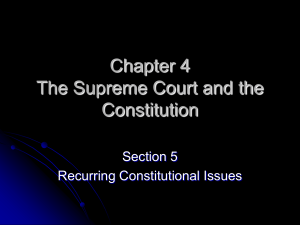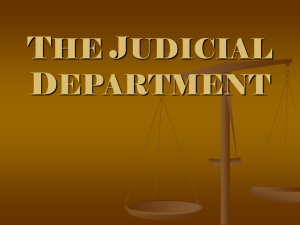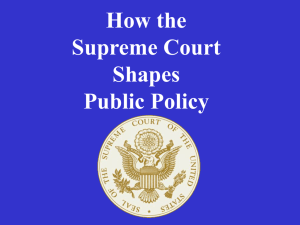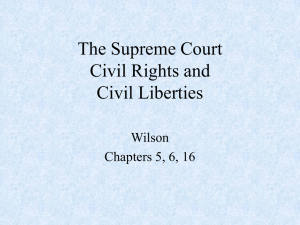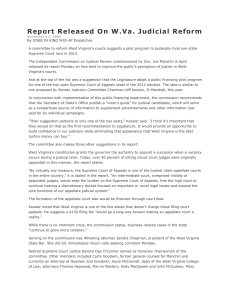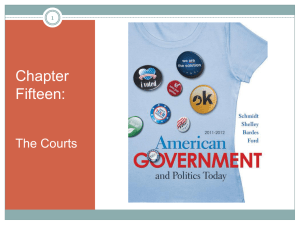Proseminar on Public Law - Department of Political Science
advertisement
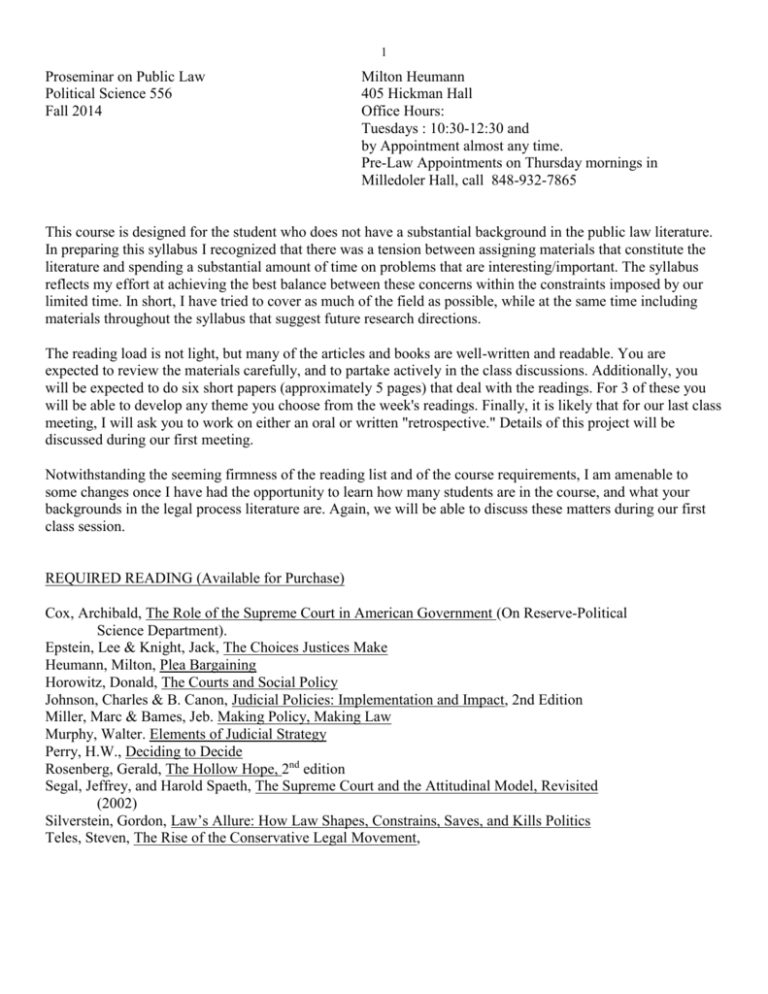
1 Proseminar on Public Law Political Science 556 Fall 2014 Milton Heumann 405 Hickman Hall Office Hours: Tuesdays : 10:30-12:30 and by Appointment almost any time. Pre-Law Appointments on Thursday mornings in Milledoler Hall, call 848-932-7865 This course is designed for the student who does not have a substantial background in the public law literature. In preparing this syllabus I recognized that there was a tension between assigning materials that constitute the literature and spending a substantial amount of time on problems that are interesting/important. The syllabus reflects my effort at achieving the best balance between these concerns within the constraints imposed by our limited time. In short, I have tried to cover as much of the field as possible, while at the same time including materials throughout the syllabus that suggest future research directions. The reading load is not light, but many of the articles and books are well-written and readable. You are expected to review the materials carefully, and to partake actively in the class discussions. Additionally, you will be expected to do six short papers (approximately 5 pages) that deal with the readings. For 3 of these you will be able to develop any theme you choose from the week's readings. Finally, it is likely that for our last class meeting, I will ask you to work on either an oral or written "retrospective." Details of this project will be discussed during our first meeting. Notwithstanding the seeming firmness of the reading list and of the course requirements, I am amenable to some changes once I have had the opportunity to learn how many students are in the course, and what your backgrounds in the legal process literature are. Again, we will be able to discuss these matters during our first class session. REQUIRED READING (Available for Purchase) Cox, Archibald, The Role of the Supreme Court in American Government (On Reserve-Political Science Department). Epstein, Lee & Knight, Jack, The Choices Justices Make Heumann, Milton, Plea Bargaining Horowitz, Donald, The Courts and Social Policy Johnson, Charles & B. Canon, Judicial Policies: Implementation and Impact, 2nd Edition Miller, Marc & Bames, Jeb. Making Policy, Making Law Murphy, Walter. Elements of Judicial Strategy Perry, H.W., Deciding to Decide Rosenberg, Gerald, The Hollow Hope, 2nd edition Segal, Jeffrey, and Harold Spaeth, The Supreme Court and the Attitudinal Model, Revisited (2002) Silverstein, Gordon, Law’s Allure: How Law Shapes, Constrains, Saves, and Kills Politics Teles, Steven, The Rise of the Conservative Legal Movement, 2 ADDITIONALLY. I ASK YOU TO READ SELECTIONS OF: McClosky, Robert, The American Supreme Court, 2nd Edition Almost all materials on the syllabus should be on reserve in the Alexander Library. The exceptions; 1) Materials to be placed in the Political Science Department, 2) Materials on SAKAI (all the articles). Indicated by CP in syllabus WEEK I: OVERVIEW OF RESEARCH ON THE SUPREME COURT Baum & Graber Exchange, “Judges and Their Audiences” Perspectives on Politics (June 2007), 335-340, CP George, Thomas, “The Qualitative Foundations of Political Science Methodology,” Perspectives on Politics (Dec. 2005), CP Gary King, “Restructuring the Social Sciences: Reflections from Harvard’s Institute for Quantitative Social Science,” PS (January 2014). Michael Tolley, “Data Sets in the Field of Law and Courts: Advancing Empirical Judicial Research,” , CP "Symposium: The State of the Field of Public Law and Judicial Politics, 1996," Law and Courts Newsletter (Spring 1996) CP “Symposium: Law and Courts,” Law and Courts Newsletter (Spring 2012) CP Law and Courts Prize Winners—2012 and 2014,CP Robert Kagan, “Somebody Loves You When You’re Down and Out: Reflections on the Law-Courts Subfield During My Academic Lifetime,” Law and Courts Newsletter (Fall 2013), CP David Mayhew, et al., "Observations on Congress. The Electoral Connection a Quarter Century After Writing It," Political Science and Politics (June 2001), CP WEEK II: THE TRADITIONAL APPROACH, SOME CASES AND SOME NEW TWISTS ON AN OLD THEME Dennis v. United States, CP Yates v. United States, CP Buckley v. Valeo, 1977, CP Elrod v. Burns, CP Swann v. Charlotte Meklenberg, CP Griswold v. Connecticut, CP Lovisi v. Slayton, CP Board of Curators of University of Missouri v. Horowitz, CP McCleskey v. Kemp, CP Graber, Mark, "Constitutionalism and Political Science; Imaginative Scholarship, Unimaginative Teaching," Perspectives and Politics (March 2005), p. 135-148, CP Judith Baer, Book Review of Constitutional Interpretation: Textual Meaning, Original Intent, and Judicial Review by Keith Whittington, APSR, Vol. 95, No. 1 (March 2001). Symposium, “Does Precedent Influence the Justices’ Voting on the U.S. Supreme Court? A Theoretical Argument,” Law & Courts (Winter 2008), CP Stanley Fish, “Does Constitutional Theory Matter,” (Jan. 2008), CP Justice William Brennan, “Constitutional Interpretation: A Contemporary Ratification,” CP Justice Antonin Scalia ,”Originalism: The Lesser Evil,” CP Justice Stephen Breyer, “Our Democratic Constitution,” CP Justice David Souter, Harvard Commencement Address, 5/27/2010, CP 3 WEEK III: THE "REVOLUTION": A SAMPLING OF THE VARIOUS BEHAVIORAL APPROACHES TO THE STUDY OF SUPREME COURT DECISION-MAKING C. Herman Pritchett, "Voting Behavior on the United Sates Supreme Court," American Court Systems (ACS), Eds. Sheldon Goldman & Austin Sarat, pp. 416-422, CP Glendon Schubert, "A Psychological Analysis of the Warren Court," (ACS), pp. 432-456, CP S. Sidney Ulmer, "Are Social Background Models Time-Bound," American Political Science Review, CP, pp. 398-404, CP Segal, Jeffrey & Harold Spaeth, The Supreme Court and the Attitudinal Model Revisited Michael Bailey and Forrest Maltzman, “Does Legal Doctrine Matter? Unpacking Law and Policy Preferences on the Supreme Court,” American Political Science Review (August 2008), CP (((Note also that they have a book on this theme: The Constrained Court: Law, Politics and the Decisions Justices Make- You might want to read this during the Winter Break!!)) Charles Cameron and Jee-Kwang Park, “How Will They Vote: Predicting the Future Behavior of Supreme Court Nominees, 1937-2006,” Journal of Empirical Legal Studies, Vol. 6, #3, September 2009, CP WEEKS IV & V: ALTERNATE BEHAVIORAL APPROACHES 1: THE LESS QUANTITATIVE APPROACHES TO SUPREME COURT DECISION MAKING Walter Murphy, Elements of Judicial Strategy Lee Epstein & Jack Knight, The Choices Justices Make J. Woodford Howard, Jr., "On the Fluidity of Judicial Choice," p. 472-478, CP J.W. Howard, "Judicial Biography and the Behavioral Persuasion," American Political Science Review, Vol. 65, 1971, CP Richard Fenno, "Observation, Context and Sequence in the Study of Politics" APSR Vol. 80 (1986) 3-15, CP Charles Johnson et al, "Strategies for Judicial Research: Soaking and Poking in the Judiciary" Judicature (Dec. Jan. 1990), CP Jeffrey Fagan and Alex Piquero, “Rational Choice and Developmental Influences on Recidivism Among Adolescent Felony Offenders,” Journal of Empirical Legal Studies, (Dec. 2007), CP WEEK VI: ALTERNATE BEHAVIORAL APPROACHES II H. W. Perry, Deciding to Decide Cornell Clayton and Howard Gillman, Supreme Court Decision Making - New Institutionalist Approaches, pp. 1-42 [On Reserve] WEEK VII: NORMATIVE PERSPECTIVES ON THE ROLE OF THE SUPREME COURT AND ...SOME DATA Archibald Cox, The Role of the Supreme Court in American Government [on reserve-5th fl. Hickman Hall] Barry Friedman, The Will of the People: How Public Opinion Has Influenced the Supreme Court and Shaped the Meaning of the Constitution, p. 3-43, 367-385, CP Robert Dahl, "Decision-Making in a Democracy: The Supreme Court as a National Policy Maker," CP, pp. 593-598 Jonathan Casper, "The Supreme Court and National Policy Making," APSR, Vol. LXX, March 1975, CP, pp. 59-99 4 Thomas M. Keck, “Party, Policy, or Duty: Why Does the Supreme Court Invalidate Federal Statutes?,” American Political Science Review, Vol. 101, #2, 2007, CP Allison Martens, “Reconsidering Judicial Supremacy: From the Counter-Majoritarian Difficulty to Constitutional Transformation,” Perspectives on Politics, (Sept. 2007), CP Keith Whittington, "Interpose Your Friendly Hand: Political Supports For the Exercise of Judicial Review by the United States Supreme Court," APSR, (Nov. 2005), CP Justin Fox and Matthew C. Stephenson, “Judicial Review as a Response to Political Posturing,” American Political Science Review, Vol. 105, #2, 2011, CP (Skim) Gregory Caldeira, "Neither the Purse Nor the Sword: Dynamics of Public Confidence in the Supreme Court," American Political Science Review Vol. 80, #4 (Dec. 1986) CIA, pp. 21 7-224 William Mishler and Reginald Sheehan, "The Supreme Court as a Counter-Majoritarian Institution? The Impact of Public Opinion on Supreme Court Decisions," APSA, Vol. 8 7, #1 (March 1993), pp. 87-101, CP James L. Gibson, “The Legitimacy of the U.S. Supreme Court in a Polarized Polity,” Journal of Empirical Legal Studies, Vol. 4, #3, Nov. 2007, CP Keith Whittington, Political Foundations of Judicial Supremacy (2007), pp. preface, 1-27, 285-296 Tom S. Clark, “The Separation of Powers, Court Curbing, and Judicial Legitimacy,” American Journal of Political Science, Vol. 53, #4, 2009, CP Brandon Bartels and Christopher Johnston, “On the Ideological Foundations of Supreme Court Legitimacy in the American Public,” American Journal of Political Science (January 2013), CP James Gibson and Michael Nelson, “ Is the U.S. Supreme Court’s Legitimacy Grounded in Performance Satisfaction and Ideology,” (American Journal of Political Science, Forthcoming 2014), CP WEEK VIII: IMPACT ANALYSIS: APPLES AND ORANGES OR A PROMISING NEW AREA Charles Johnson, & Bradley Canon, Judicial Politics: Implementation & Impact Charles Franklin and Liane Kosaki, "Republican Schoolmaster: The U.S. Supreme Court, Public Opinion and Abortion." APSR (Sept. 1989) CP Jeffrey K. Staton and Georg Vanberg, “The Value of Vagueness: Delegation, Defiance, and Judicial Opinions,” American Journal of Political Science, Vol. 52, #3, 2008, CP WEEK IX: IMPACT II Gerald Rosenberg, The Hollow Hope Thomas M. Keck, “Beyond Backlash: Assessing the Impact of Judicial Decisions on LGBT Rights,” Law and Society Review, Vol. 43, #1, 2009, CP Reviews of : Mathew Hall, The Nature of Supreme Court Power (2013; another book for Winter break reading!) WEEK X: COURTS, LAW, CRITICAL ANALYSES AND TAKING STOCK OF WHERE WE ARE AND WHERE WE MIGHT GO Martin Shapiro, "The European Court of Justice," in Paul Craig and Grainne de Burca, The Evolution of EU Law (Oxford, 1999) CP Paul Brace and Kellie Butler, "New Perspectives for the Comparative Study of the Judiciary: The State Supreme Court Project," Justice System Journal, Vol 22, #3, 2001 Ran Hirschl, “The Political Origins of Judicial Empowerment Through Constitutionalization: Lessons from Four Constitutional Revolutions,” Law and Social Inquiry, Vol. 25, #1, 2000 5 R. Daniel Kelemen, “Suing for Europe: Adversarial Legalism and European Governance,” Comparative Political Studies, Vol. 39, #1, 2006 Alec Stone Sweet and Thomas Brunell, “The European Court of Justice, State Noncompliance, and the Politics of Override,” American Political Science Review, Vol. 106, #1, 2012 Clifford J. Carruba, Matthew Gabel, and Charles Hankla, “Understanding the Role of the European Court of Justice in European Integration,” American Political Science Review, Vol. 106, #1, 2012 Diana Kapiszewski, “Tactical Balancing: High Court Decision Making on Political Crucial Cases,” Law and Society Review (2011) CP Veronica Michel, “ Human Rights Prosecutions and the Participation Rights of Victims in Latin America,” Law and Society Review (2013), CP Lee Epstein, Jack Knight & Olga Shvetsova, “The Role of Constitutional Courts in the Establishment and Maintenance of Democratic Systems of Government,” The Role of Constitutional Courts. Melinda G. Hall, “State Supreme Courts in American Democracy: Probing the Myths of Judicial Reform,” APSR, Vol. 95, No. 2 (June 2001). James L. Gibson, “Challenges to the Impartiality of State Supreme Courts: Legitimacy Theory and “New Style” Judicial Campaigns,” American Political Science Review, (Feb. 2008), CP Noah Feldman, “What a Liberal Court Should Be,” NYT Magazine 6/27/2010, CP WEEK XI: THE COURTS AND SOCIAL POLICY 1: YET ANOTHER "NEW" PERSPECTIVE ON THE ROLE OF COURTS IN THE POLITICAL SYSTEM Horowitz, Donald, The Courts and Social Policy (Selected Sections) Teles, Steven, The Rise of the Conservative Legal Movement (2008) Epp, Charles R., Making Rights Real, p. 1-30, 215-231, CP WEEK XII: THE COURTS (FEDERAL AND STATE) AND SOCIAL POLICY: LAW IN THE LEGAL AND POLITICAL PROCESS Miller, Mark & Barnes, Jeb, Making Policy, Making Law Silverstein, Gordon, Law’s Allure: How Law Shapes, Constrains, Saves and Kills Politics Skim the Following Four Articles: Paul Frymer, “Acting When Elected Officials Won’t: Federal Courts and Civil Rights Enforcement in U.S. Labor Unions, 1935-85,” American Political Science Review, Vol. 97, #3, 2003, CP Sean Farhang, “Public Regulation and Private Lawsuits in the American Separation of Powers System,” American Journal of Political Science, Vol. 52, #4, 2008, CP Georg Vanberg, “Legislative-Judicial Relations: A Game-Theoretic Approach to Constitutional Review,” American Journal of Political Science, Vol. 45, #2, 2001, CP Jeb Barnes, “Making Way: Legal Mobilization, Organizational Response, and Wheelchair Access,” Law and Society Review (2012), CP WEEK XIII: TRIAL COURTS AND FISH MARKETS: THE ADVERSARY SYSTEM AND PLEA BARGAINING Marie Gottschalk, The Prison and the Gallows, (1-40, 236-263) CP Herbert Packer, "Two Models of the Criminal Process," in George Cole ed., Criminal Justice, CP Milton Heumann, Plea Bargaining Milton Heumann, “Plea Bargaining Revisited: Understandings of Negotiated Justice in the Twenty-First Century,” Criminal Law Bulletin (2013), CP 6 Vesla M. Weaver and Amy E. Lerman, “Political Consequences of the Carceral State,” American Political Science Review, Vol. 104, #4, 2010 Daniel F. Wilhelm and Nicholas R. Turner, “Is the Budget Crisis Changing the Way We Look at Sentencing and Incarceration?,” Vera Institute Working Paper, June 2002 Sanford Gordon, “Assessing Partisan Bias in Federal Public Corruption Prosecutions,” American Political Science Review (2009) , CP Regina Bateson, “Crime Victimization and Political Participation,” American Political Science Review (2012), CP WEEK XIV: BROADER PERSPECTIVES ON TRIAL COURTS: ORGANIZATION THEORY AND POLITICAL CULTURE Symposium, “Exploring the (dis) Connections between Political Science and Law & Society,” Law & Courts Newsletter, Winter 2007, CP Lynn Mather, "Theorizing About Trial Courts: Lawyer, Policy Making, & Tobacco Litigation," Law and Social Inquiry (1998) CP Martin Levin, "Urban Politics and Judicial Behavior," Journal of Legal Studies, Vol. 1, Issue #193, 1972 Thomas Church, "Examining Local Legal Culture," American Bar Foundation Research Journal, (1985) Paul Butler, “Racially Based Jury Nullification: Black Power in the Criminal Justice System" Yale Law Journal, 1995 CP U.S. v. Booker, CP Chris Suellentrop, “The Right Has a Jailhouse Conversion,” (Dec. 2006), CP Frances Zemans, "Legal Mobilization: The Neglected Role of the Law in the Political System, APSR, Vol. 77 #3, September 1983, pp. 45-51, CP William L.F. Felstiner, Richard L. Abel, and Austin Sarat, “The Emergence and Transformation of Disputes: Naming, Blaming, Claiming…,” Law and Society Review, Vol. 15, #3-4, 1980-81, CP Marc Galanter, "Why the 'Haves' Come Out Ahead: Speculations on the Limits of Legal Change," Law and Society Review, Vol. 9, #1, Fall 1974, CP CONCLUSIONS: Review the various themes developed this semester. Depending on the enrollment in the course, some sort of written or oral "retrospective exercise" will be conducted. We may schedule an additional evening session if oral presentations are chosen. I'll have more to say about this after the first class.

